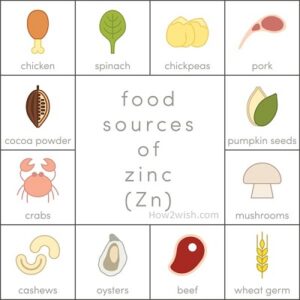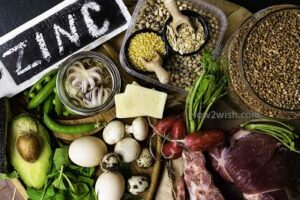Everyone who monitors their health knows that for the well-coordinated work of the body, good health, and well-being, you need to eat right. The diet must contain foods containing vitamins and minerals since these nutrients are involved in a huge number of important biological processes and you simply cannot do without them.

One of the trace elements that the body needs daily is zinc. It has antioxidant properties, supports skin health, promotes wound healing, strengthens the immune system, and stimulates many intracellular processes that affect the growth and development of the body. That is why this nutrient should not be underestimated.
Interesting fact: Zinc is the second most abundant trace element in the human body after iron.
Benefits of zinc for the body
Numerous studies confirm the fact that this microelement plays a leading role in supporting the health of each of us.
- Strengthens immunity. The trace element directly affects the functioning of immune cells and reduces oxidative stress. Thus, the body fights colds more effectively.
- Accelerates the healing process. Zinc has proven itself in the treatment of wounds, burns, ulcers, and a number of skin diseases. It is important to note that the microelement takes part in the synthesis of collagen, reduces inflammation, and stimulates the regeneration of the skin.
- Helps get rid of acne. Practice shows that both oral and topical treatment with zinc helps fight rashes. As a result, tissue inflammation is reduced, the growth and development of acne-causing bacteria are prevented, and the work of the sebaceous glands is regulated.
- Helps with hair loss. Nutrient supports hair growth and strengthens them.
- Works as a powerful antioxidant. As already noted, the trace element helps fight oxidative stress and reduces the risk of some serious diseases.
- Supports eye health. Would you ever think? And this is true. Zinc takes part in the transformation of vitamin A into its active form, which is so important for the organs of vision.
- Regulates the work of hormones and the reproductive system. This mineral is necessary for the production of hormones such as estrogen and progesterone in women, it also increases testosterone levels and improves sperm quality in men. In addition, zinc is essential for stabilizing insulin levels, the hormone responsible for regulating blood sugar levels.
- Improves the absorption of nutrients. The trace element affects protein synthesis and is essential for the absorption of amino acids from food. It is also involved in the breakdown of carbohydrates.
- Favorably influences pregnancy. Zinc is needed for DNA synthesis, the creation and growth of cells, and the full development of the child in the womb. Therefore, it is so important to monitor the diet during pregnancy.
Of course, this is not the end of the list. We can talk about the benefits of the mineral for a long time, but we will not delve into it, because we still need to talk about other equally important points.
Daily intake
Since this microelement is not synthesized by the body and cannot accumulate in it, it is necessary to include foods containing zinc in your diet. The need for a mineral is different for everyone, so in order for you to set the rate for yourself, let’s turn to the table.
Age For men For women During pregnancy During lactation
0-6 months 2 mg 2 mg
7-12 months 3 mg 3 mg
1-3 years 3 mg 3 mg
4-8 years old 5 mg 5 mg
9-13 years old 8 mg 8 mg
14-18 years old 11 mg 9 mg 12 mg 13 mg
19+ years old 11 mg 8 mg 11 mg 12 mg
The maximum allowable intake of zinc per day for adults is 40 mg (including food and nutritional supplements).
Signs of deficiency
In fact, the lack of zinc in the body is not so common but still takes place. Deficiency states are most often accompanied by the following symptoms:
- loss of appetite;
- the presence of skin diseases;
- hair loss;
- frequent colds;
- dulling of taste buds;
- growth retardation in children.
Most often, people with gastrointestinal diseases, during pregnancy and breastfeeding, and people with special nutritional needs (vegetarians and vegans) face a lack of zinc in the body.
Foods High in Zinc
Zinc is an essential mineral that plays a crucial role in various bodily functions such as immunity, wound healing, DNA synthesis, and protein synthesis. It also contributes to healthy growth and development, taste and smell, and reproductive health. Zinc deficiency can lead to several health problems such as impaired immune function, stunted growth, hair loss, diarrhea, and delayed wound healing. The recommended daily intake of zinc for adults is 8-11 mg for women and 11-15 mg for men. In this article, we will discuss the top foods high in zinc and their benefits.

Top 10 Foods High in Zinc
- Oysters
- Beef
- Pork
- Chicken
- Beans
- Nuts and seeds
- Dairy products
- Whole grains
- Seafood
- Dark chocolate
Oysters
Oysters are the richest source of zinc, containing 74 mg per 100 grams. They also provide other nutrients such as omega-3 fatty acids, vitamin B12, and iron. Oysters have anti-inflammatory properties and may improve heart health and brain function.
Beef
Beef is another excellent source of zinc, containing 7 mg per 100 grams. It also provides high-quality protein, iron, and vitamin B12. Lean cuts of beef are also low in calories and can be a part of a healthy diet.
Pork
Pork is a rich source of zinc, containing 4.4 mg per 100 grams. It is also a good source of thiamine, selenium, and vitamin B12. Pork is versatile and can be cooked in different ways, making it a great addition to any meal.
Chicken
Chicken is a good source of zinc, containing 1.6 mg per 100 grams. It is also a rich source of protein and low in fat. Chicken can be cooked in various ways, making it a healthy and delicious choice for any meal.
Beans
Beans are a plant-based source of zinc, containing 2.7 mg per 100 grams. They also provide fiber, protein, and various vitamins and minerals. Eating beans regularly can improve gut health and lower the risk of chronic diseases.
Nuts and Seeds
Nuts and seeds are a great source of zinc, containing 2-3 mg per 100 grams. They also provide healthy fats, fiber, and other nutrients such as vitamin E and magnesium. Eating nuts and seeds regularly may reduce the risk of heart disease and improve brain function.
Dairy Products
Dairy products such as cheese and yogurt are a good source of zinc, containing 1-2 mg per 100 grams. They also provide calcium, protein, and other nutrients. Dairy products can improve bone health and may lower the risk of certain cancers.
Whole Grains
Whole grains such as quinoa and brown rice are good sources of zinc, containing 1-2 mg per 100 grams. They also provide fiber, protein, and other nutrients such as magnesium and B vitamins. Eating whole grains regularly can lower the risk of heart disease and diabetes.
Seafood
Seafood such as crab and lobster are a good source of zinc, containing 1-3 mg per 100 grams. They also provide healthy fats, protein, and other nutrients such as selenium and vitamin B12. Eating seafood regularly may improve heart health and brain function.
Dark Chocolate
Dark chocolate is a surprising source of zinc, containing 3.3 mg per 100 grams. It also provides antioxidants and other nutrients such as iron and magnesium. Eating dark chocolate in moderation may lower the risk of heart disease and improve mood and cognitive function.
Looking at this table, we can say with confidence that it is quite possible to cover the daily requirement of the body for zinc. When compiling a diet, it should be borne in mind that food of animal origin is best absorbed, since it does not contain phytic acid, which blocks the absorption of the microelement. While in plant foods e’ abound. But there is one simple way to get rid of phytic acid – to give food to heat treatment.
Interesting on the topic 900+ Super Motivational Quotes, Messages, Status 2023
Since there is no food of animal origin in the diet of vegetarians and vegans, this category of people receives a considerable amount of phytic acid, against which deficient states can develop. There is a way out of this situation – controlling the level of zinc in the body, as well as taking food supplements.
Plan your diet right and take care of your health by supporting it with essential nutrients!
FAQ
What are some foods high in zinc?
Foods that are high in zinc include oysters, beef, pork, chicken, beans, nuts, and whole grains.
Why is zinc important?
Zinc is an essential mineral that plays a crucial role in many bodily functions, including immune system function, wound healing, and cell growth and division.
How much zinc do I need each day?
The recommended daily intake of zinc varies depending on age, gender, and other factors. However, in general, adult men need around 11 mg of zinc per day, while adult women need around 8 mg per day.
Can I get enough zinc from my diet alone?
In most cases, it is possible to get enough zinc from your diet alone, especially if you eat a varied diet that includes foods high in zinc. However, some people may need to take zinc supplements to meet their daily needs.
What are some signs of zinc deficiency?
Signs of a zinc deficiency can include hair loss, poor wound healing, a weakened immune system, and loss of appetite. However, these symptoms can also be caused by other factors, so it’s important to consult a healthcare provider if you’re concerned about your zinc intake


